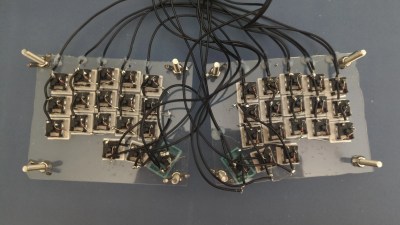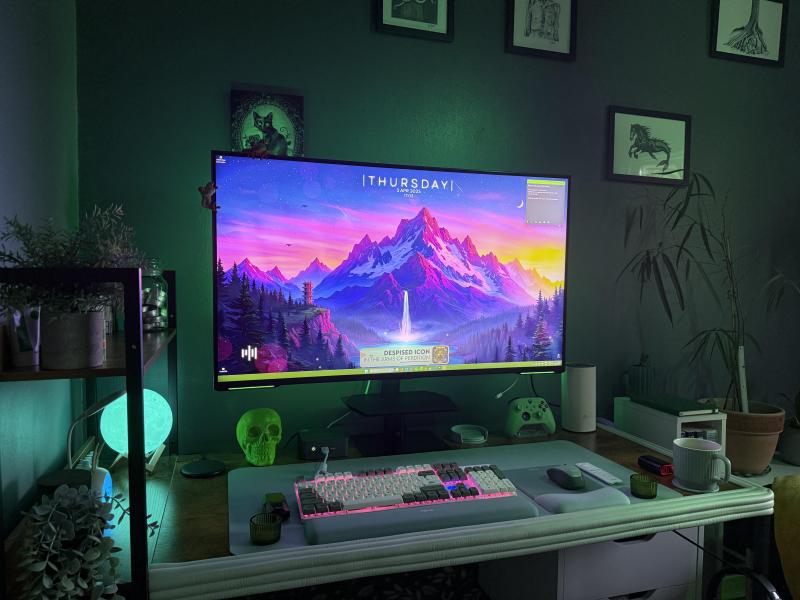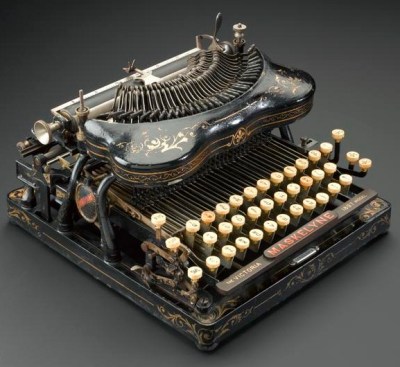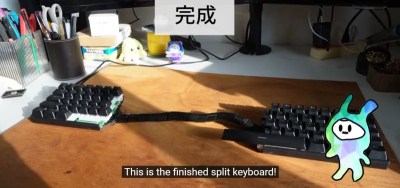Yeah, yeah — not a keyboard. But one keyboard-adjacent topic I’m certainly interested in is that of finding a satisfying mouse. Why settle for ticky micro-switches when you could have full-on thock in both peripherals?

I’ve been using a Logitech Ergo M575 for a couple of years now. As you can see, it’s a trackball with two extra buttons, which come programmed for forward and back. I find this next to useless, so I employed AutoHotKey and changed them to Ctrl+C on the up switch, and Ctrl+V on the down switch.
[Aknup] commented on the previous Keebin’ and brought up MMO mice, which, I didn’t know those things had a name other than maybe ‘multi-button mice’. And yes, there are a few trackball MMOs out there. I’ve got my eye on a couple already.
Does anyone have a trackball MMO? I hate to spend $100+ on something I won’t like. I’m intrigued that the one I found that’s the most attractive is less a thumb trackball and more a two-fingers-at-once kind of situation. That will take some getting used to, but the way my trackball moves sometimes, it could be a really positive change.
Embrace the Jank, Why Don’t You?
[VideoPuzzleheaded884] built this keyboard over a the course of a few evenings for a total cost of around $30 AUD ($18.33 USD as of this writing), as a way to motivate themselves to finally start soldering.

You can tell [VideoPuzzleheaded884] is one of us — they cobbled this Corne mini layout-having keyboard together with stuff on hand, and did a fine job of soldering one of their first projects. Hey, if it works, it works. And the use of all-black wires should be commended.
The microcontroller is an ESP32-C3 [VideoPuzzleheaded884] found in box somewhere, and the switches are Gateron Silvers from an unknown time. All in all, this project was a fun diversion from programming, and this probably won’t be the last keyboard they solder.
The Centerfold: Alas, Poor Yorick; I Knew Thee Cozy Vibes Well

The moon lamp looks great along with the fill light coming in from the right, and I could totally get down with some death metal and WFH with this setup.
Do you rock a sweet set of peripherals on a screamin’ desk pad? Send me a picture along with your handle and all the gory details, and you could be featured here!
Historical Clackers: Oh Maskelyne, Why Can’t You Be True?
What’s a magician to do if they need something to fall back on? Sell typewriters, I suppose. Why else would a father-and-son team of illusionists named John Nevil Maskelyne (Jr. and Sr.) do such a thing?

The Maskelynes’ machine was initially seen at the Paris World’s Fair, which lasted from May to October 1889. Four years later, it finally hit the market.
The main selling point of the Maskelyne was that it offered differential spacing. Most typewriters output monospaced text — the skinny ‘i’ takes up the same width on the page as the ‘w’ does. On the Maskelyne, each character takes up a different amount of horizontal space. This makes for a nicer-looking document overall.
By 1897, the writing was on the wall. Maskelynes under heavy usage were falling apart. They were not built to withstand the vibration that typewriters must endure. As a result, things would go awry — maybe the escapement clutch no longer moved far enough, or went too far, or the bars needed to make differential spacing possible clashed together.
By the third model of Maskelyne, they did away with differential spacing. But the investors were unhappy, and by 1899, the Maskelyne Typewriter concern did a disappearing act.
ICYMI: Stop Me If You Saw This Keyboard
We’re embracing the jank this week, remember? And the end result of [nomolk]’s labor? Not janky at all.

This labor of love took almost three weeks, between rewiring all the broken connections and testing the wiring. [nomolk] tried it out and found it wasn’t working as expected, with some keys not registering, and other keys registering two characters.
Once it was working, [nomolk] had a fine mess of all-black wires (!) to deal with. Between the zip ties and the plastic spiral wire wrap thingy, the beast was eventually tamed. That Spacebar would drive me crazy, though.
Got a hot tip that has like, anything to do with keyboards? Help me out by sending in a link or two. Don’t want all the Hackaday scribes to see it? Feel free to email me directly.
















I used to have that same trackball, Kristina – until I started getting tendon pain in my right arm. I had to move to a Kensington with the ball in the middle to give my thumb some relief. No trouble yet on the index and middle finger combo I use on the ball these days.
I have “Doom thumb” from using that same trackball – I will try the Kensington one, thanks for the tip!
The tendons on the top of my hand get sore just thinking about using a non-thumb trackball.
I like to use the extra mouse buttons for expose´ and show desktop. that way I can drag something from one window to somewhere behind that window or navigate into any other window in the layers with just the one hand. And without having to do a separate click first or do a multi fingered keyboard shortcut at the same time. These functions used in conjunction with mouse movements anyway. using the extra buttons as keyboard keys like backspace always seems in appropriate.
My extra mouse buttons are configured as Control and Shift. Shift/Control click + drag in CAD are now one handed!
I used a Corsair Scimitar for a couple of years. 12 buttons on the side of it. I experimented with using it in games (the buttons were all customizable by Corsair’s iCue software) but I found it kind of awkward and eventually gave up on it. One thing of note was the keypad part was on a rail so you could slide it forward or backward a bit.
I find that series of Bluetooth trackball especially brilliant for working while out and about. Much nicer than laptop touchpad. No need to wiggle a mouse on your leg or find a clear spot on a table. I even wonder about attaching it to the side of a laptop somehow… The only flaw is if you drop it, the ball can roll far away…
I used to love Logitech trackballs, but my old faithful PS2 model finally wore out (and the PS2 USB adapter was janky). Then I went through 3 nice new wireless ones in a year with the switches wearing out – missed clicks, random scroll direction, spurious button up/down in the middle of dragging – before finally giving up. Now I have an elecom that is not as nice, but seems reliable so far.
Got to give a shout out to my Ergo Huge, the software for it as all good Japanese software should be is from Windows 95 era, but it works without issue for me, also there is a great youtube video with a slightly drunk switching his bearings to ceramic ones which do give a great improvement.
Fun fact #34928579348593485793485:-
The next in the Maskelyne line (Jr’s son, Jasper) is credited as the inventor of modern military camouflage and misdirection tactics like inflatable tanks.
They wanted him to go into the family business, but he wasn’t the type.
Pay toilet invention, spend a penny!
AutoHotKey, where have you been all my life? Thanks, Kristina!
A better choice is X-Mouse, handles lots of buttons and you don’t have to code anything
Link: https://www.highrez.co.uk/downloads/xmousebuttoncontrol.htm
haha that’s great… i don’t like having copy-and-paste as mouse buttons (which is still a default for X11 i guess), because i so often have a limited set of mouse buttons (2, 1, or even 0 buttons is not uncommon in my life, somehow). and here you are the exact opposite, having so many mouse buttons that you’re converting them to copy and paste because you don’t know what else to do with them.
I’m a trackball zealot. The Elecom HUGE is okay (I have two), but their synthetic ruby static bearings are hot garbage and, if they’re not already bad out of the box, will be all but useless after a month or two of usage. Replacing the bearings with something a little better like silicon nitride or zirconium works for a while, but it’s still “sticktion”-prone.
I also have Elecom’s Deft Pro, the older Deft and so on.
The smoothest non-modified one I own is the newest Kensington Slimblade Pro. It has four buttons and the newest release of the software can map modifiers and combos to stretch those out.
I like my Ploopy Nano, but it requires more effort to get it working like a “normal” mouse (macropad or keyboard bindings to cover right/left-click and so on).
My favorite, by far, with no exception: my current-gen X-Keys L-Trac with an aftermarket (Aramith) ball and the steel rollers replaced with steel shafts, ABEC bearings and 3D printed supports. It has two 3.5mm jacks at the rear for attaching or otherwise wiring up “extra” buttons. They were intended for use with foot switches and so on, but they work really well for arcade buttons as back/forward and so on. With a little libinput hackery it covers everything I need from it.
Fingerballs are also way more accurate and, at least for me, don’t make my injuries flare up. I can only use a thumbball for a few minutes before I put it aside and switch back.
I’m surprised to hear that folks have that much trouble with thumb-centric trackballs. I shall consider myself lucky to have gotten so much mileage out of them over the years